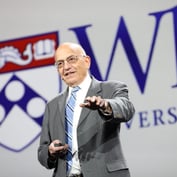By
The collapse of energy conglomerate Enron Corp. and the substantial loss of retirement savings by a number of employees that followed have many questioning the wisdom of allowing 401(k) participants to disproportionately fill their retirement plan with company stock.
Washington is responding by readying legislation on pension reform. (See NU, March 25.)
With legislation pending and uncertainty as to what shape a pension reform bill will finally take, there is no telling how it might affect the 401(k) industry, says Jack VanDerhei, a faculty member of the Fox School of Business and Management at Temple University, Philadelphia, and a Fellow of the Employee Benefits Research Institute, Washington.
He recently prepared a report that investigates the effects of the Enron debacle through an outline of the makeup of large 401(k) plans (with 5,000 or more employees) and small (with fewer than 5,000 employees).
VanDerhei surveyed members of the International Society of Certified Employee Benefit Specialists whose client/employer sponsors a 401(k) plan.
Forty-eight percent of respondents say there is a company stock investment option in their client/employers plan.
Large plans have a company stock option in their 401(k) program 73% of the time, whereas small plans have a company stock option 32% of the time.
Among plans that have a company stock option, 39% of employees have less than 10% invested in company stock; 42% of employees have 10%-50% invested in company stock; and 18% of employees have 50% invested in company stock.
Forty-three percent of companies that have a company stock investment option are required to invest contributions in company stock.
Among companies that have a company stock option, 49% of large plans require employers contributions to be invested in company stock; only 38% of small plans do so.
Of the plans in which employer contributions are required to be invested in company stock, 60% of respondents said participants are restricted from selling company stock until a specified age and/or service requirement was met; 27% reported there are restrictions throughout a participants investment in the plan; and 13% reported no restrictions.
Fourteen percent of those with a company stock investment option said there are limits on the amount or percentage of company stock a participant could have in his 401(k) plan.
The report indicates that blackout periods are shorter in large plans than small. A blackout, referred to by some as “lockdown” is a period of time that a company is changing the management of its retirement account and during which participants are suspended from switching their investments.
The duration of the blackout period does not appear to be affected by whether or not there is a company stock option, the report says. However, the blackout period is slightly longer when employer contributions are required to go into company stock.








 March 31, 2002 at 07:00 PM
March 31, 2002 at 07:00 PM










